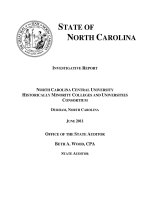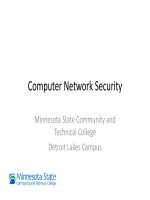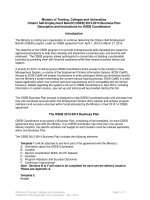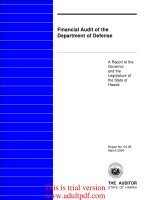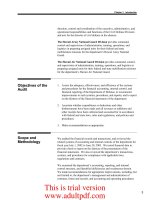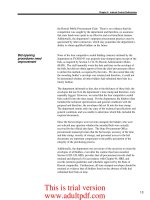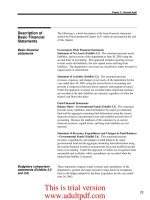Minnesota State Colleges and Universities Selected Scope Audit of the Student Information System Tuition and Accounts Receivable Module as of June 1999_part1 pdf
Bạn đang xem bản rút gọn của tài liệu. Xem và tải ngay bản đầy đủ của tài liệu tại đây (71.75 KB, 11 trang )
Minnesota State Colleges and Universities
Selected Scope Audit of the Student Information System
Tuition and Accounts Receivable Module as of June 1999
October 1999
Financial Audit Division
Office of the Legislative Auditor
State of Minnesota
99-53
Centennial Office Building, Saint Paul, MN 55155 l 651/296-4708
This document can be made available in
alternative formats, such as large print,
Braille, or audio tape, by calling 296-1727
SUMMARY
State of Minnesota
Office of the Legislative Auditor
1st Floor Centennial Building
658 Cedar Street • St. Paul, MN 55155
(651)296-1727 • FAX (651)296-4712
TDD Relay: 1-800-627-3529
email:
URL:
Minnesota State Colleges and Universities
Information System Application Review
Selected Scope Audit of the Student Information System (SIS)
Tuition and Accounts Receivable Module
As of June 1999
Public Release Date: October 1, 1999 No. 99-53
Background
Minnesota State Colleges and Universities (MnSCU) began operations on July 1, 1995, and
includes three state-level higher education systems: state universities, community colleges, and
technical colleges. Currently, MnSCU consists of 36 different institutions at 54 campus
locations with estimated tuition revenues of $245 million for fiscal year 1999.
MnSCU designed and developed its computerized business systems in-house. The accounts
receivable module of the Student Information System (SIS) controls tuition assessments,
collections, and outstanding receivables by automatically:
• assessing tuition as a result of registration activity;
• charging course fees, along with standard and special student fees;
• posting collections against student tuition and fee charges;
• applying financial aid funds to the students’ accounts; and
• posting the appropriate accounting transactions.
Three pilot schools began using the new accounts receivable module in the fall of 1997. The
remaining institutions were phased into the module.
Selected Audit Areas and Conclusions
Our audit focused on the application controls over tuition and fee assessments, collections,
student accounts receivable balances, and the accounting transactions that result from these
activities and processes. Application security controls were reviewed. We utilized MnSCU
databases to assess the integrity of the rate tables, registration and collection data, and resulting
calculations and accounting transactions.
We found that the system properly assessed tuition and fees, applied collections and financial aid
properly, maintained student balances, and posted the appropriate accounting entries. We did,
however, note some concerns with application security controls. Two security groups were
designed with excessive clearance to incompatible functions and institutions did not adequately
restrict access based on job responsibilities. We also found that negative receipt transactions
were vulnerable, and management reports are needed for registration cancellations, waivers, and
aging of unpaid accounts receivables.
The MnSCU system office agreed with the findings and recommendations contained in the audit
report and are working to resolve the issues identified.
STATE OF MINNESOTA
OFFICE OF THE LEGISLATIVE AUDITOR
JAMES R. NOBLES, LEGISLATIVE AUDITOR
Representative Dan McElroy, Chair
Legislative Audit Commission
Members of the Legislative Audit Commission
Mr. Morris J. Anderson, Chancellor
Minnesota State Colleges and Universities
Members of the Minnesota State Colleges and Universities Board of Trustees
We have performed a selected scope information systems audit as further explained in Chapter 1. We
emphasize this has not been a complete audit of all aspects of MnSCU’s computer systems. Our audit
focused on the application controls over MnSCU’s Student Information System modules impacting
student tuition and fee assessments, collections, outstanding accounts receivable balances, and the
resulting accounting transactions. The audit Summary highlights the specific audit objectives and our
conclusions. We discuss these issues more fully in the individual chapters of this report.
We conducted our audit in accordance with Government Auditing Standards, as issued by the
Comptroller General of the United States. Those standards require that we obtain an understanding of
management controls relevant to the audit. The standards also require that we design the audit to
provide reasonable assurance that the Minnesota State Colleges and Universities complied with the
provisions of laws, regulations, contracts, and grants significant to the audit. The management of
MnSCU is responsible for establishing and maintaining the internal control structure and for compliance
with applicable laws, regulations, contracts, and grants.
This report is intended for the information of the Legislative Audit Commission and the management of
Minnesota State Colleges and Universities. This restriction is not intended to limit the distribution of this
report, which was released as a public document on October 1, 1999.
James R. Nobles Claudia J. Gudvangen, CPA
Legislative Auditor Deputy Legislative Auditor
End of Fieldwork: July 8, 1999
Report Signed On: September 27, 1999
1ST FLOOR SOUTH, CENTENNIAL BUILDING l 658 CEDAR STREET l ST. PAUL, MN 55155
TELEPHONE 651/296-4708 l TDD RELAY 651/297-5353 l FAX 651/296-4712 l WEB SITE
MnSCU – Student Information System Application Review
Table of Contents
Page
Chapter 1. Introduction 1
Chapter 2. Application Security Controls 5
Chapter 3. System Processing 9
MnSCU Response 15
Audit Participation
The following members of the Office of the Legislative Auditor prepared this report:
Claudia Gudvangen, CPA Deputy Legislative Auditor
Brad White, CPA, CISA Audit Manager
Eric Wion, CPA, CISA Auditor-In-Charge
Keith Bispala Senior Auditor
Jason Stauffenecker Senior Auditor
Exit Conference
We discussed the findings and recommendations with the following representatives of the Minnesota
State Colleges and Universities (MnSCU) system office on September 13, 1999:
Laura King Vice Chancellor, Chief Financial Officer
Rosalie Greeman Associate Vice Chancellor, Financial Reporting
Al Finlayson Director of System Accounting
Deb Winter Director of Campus Accounting
Dale Jarrell System Director, Policy, Planning, and Services
John Asmussen Executive Director, Internal Auditing
Beth Buse Deputy Director, Internal Auditing
MnSCU – Student Information System (SIS) Application Review
1
Chapter 1. Introduction
The Minnesota State Colleges and Universities (MnSCU) system began operations on July 1,
1995. The new MnSCU system combined two state-level higher education systems, state
universities and community colleges that had previously existed as independent systems. It also
incorporated several technical colleges into state government. In total, MnSCU now consists of
36 different institutions with 54 campus locations. MnSCU’s colleges and universities serve
approximately 230,000 students in for-credit courses, 100,000 students and 3,200 businesses
through customized training, and 100,000 students in non-credit continuing education programs
1
.
MnSCU estimated it would collect $245 million in tuition during fiscal year 1999
1
.
Prior to the higher education merger, MnSCU made a decision to develop a collection of new
computer systems, or modules, to help institutions manage their business activities. This system
development effort, referred to as the Integrated Statewide Records System (ISRS), began in
early 1994 and is still underway. Accounting, Human Resources (SCUPPS), and Purchasing
(PCS) were among the first modules implemented. Other modules including Curriculum, Term
Course, Registration, and Accounts Receivable were available for the fall 1998 semester. These
four modules, and several others, have collectively been termed the Student Information System
(SIS). In the fall of 1997, Moorhead State University, Metropolitan State University, and
Minnesota West Community and Technical College implemented several of the modules as part
of the SIS pilot. At the time of our audit, institutions continued to implement SIS on a phased-in
basis.
MnSCU has been implementing its new business systems in a complex computing environment
called “client server.” Client server refers to a special type of environment where several
different computers work together to accomplish a task. Typically, these computers are
connected and communicate over a high-speed local or wide area network. With all the MnSCU
modules, a user’s personal computer (i.e. the client) completes a portion of the computer
processing. The remaining processing occurs on a central computer at one of MnSCU’s four
regional data centers. Communications between campus machines and the central data center
computers occur over the State of Minnesota’s wide area network.
Each institution stores its business data in its own production database. MnSCU houses each
institutional database at one of the four data centers and connects them to the central computer at
that site. This connection and the State of Minnesota’s wide area network give campus users
instantaneous access to their business data. In addition, an exact copy of each institution's
production database is made every night. This copy, referred to as an institution’s replicated
database, gives users a tool for ad-hoc reporting. We used an extensive amount of data stored in
institutional databases to conduct much of our audit work.
All the courses offered by an institution comprise its curriculum. The courses offered are entered
in the Curriculum module and used to generate a Course Catalog. The Term Course module is
1
Minnesota Biennial Budget, Higher Education 2000-2001.
MnSCU – Student Information System (SIS) Application Review
2
used to schedule specific courses that the institution will be offering for any given school term.
Students register for particular course offerings using the Registration module. The system
provides three methods of registration that include phone, web, and traditional. The traditional
method requires a registration employee to obtain information from the student and then input
the data into the system, while phone and web registration allow students to enter information
directly into the system. The Accounts Receivable module tracks receivables from the time a
student registers until their final disposition. The module automatically:
• charges tuition as a result of registration activity;
• adjusts tuition charges when courses are added or dropped;
• charges course fees, and standard and special student fees;
• posting collections against student tuition and fee charges;
• applies financial aid funds to the student’s accounts; and
• posts the related accounting transactions to the appropriate accounting system cost center
or general ledger.
Since the Accounts Receivable and Accounting modules are fully integrated, universities and
colleges are not required to separately input or reconcile data from independent systems. The
system, however, was not designed to encompass customized training assessments and
collections. In addition, other receivables may be created manually. For example, student fines,
rental of space, or sale of services to non-student customers are charges that an institution may
create manually.
Figure 1-1 depicts the flow of information between SIS modules.
MnSCU’s Office of Internal Auditing performed a review of this system and released an audit
report January 20, 1999, titled Student Information System. This report was critical of MnSCU’s
system development methodology, suggesting MnSCU was ill equipped to develop its own
software in-house. System development occurred without the benefit of a structure that
promoted user participation, testing, and acceptance. The report indicated that insufficient
Figure 1-1
Minnesota State Colleges and Universities
Student Information System Flow of Information
MnSCU – Student Information System (SIS) Application Review
3
resources were invested in testing the quality of software modules, developing training programs
and gaining user acceptance, and documenting system design and processes.
We believe the following key concerns identified in the Internal Audit report, or through our
observations, increased the risk that the system may produce erroneous information:
• SIS computerized software (application screens) were placed into production prior to
being thoroughly tested. We observed several situations where campus users
encountered problems with specific application screens. MnSCU dealt with these
situations by alerting system users to discontinue use of the screens until they were
working properly. Ideally, new and modified screens should be tested prior to release to
avoid user errors and frustration.
• MnSCU lacked some technical documentation providing an understanding of system
data, tables, and interrelationships. For example, there is no comprehensive data
dictionary defining SIS tables and interactions. MnSCU has begun to develop user
documentation describing business processes and screen information; however, technical
documentation could be improved.
• MnSCU placed substantial responsibility for system design on one individual and
primarily relied on that person for ongoing knowledge and understanding of the system.
If this individual was to leave or transfer, MnSCU may encounter difficulties or
inefficiencies in understanding key system design and logic. Ideally, the technical
documentation described above would alleviate inefficiencies caused by the loss of
individuals with vital system knowledge.
Because of these conditions, we felt an application review of the SIS modules would provide the
MnSCU system office with assurances that data integrity and processing logic produced
reasonable results.
Our audit focused on the application controls over tuition and fee assessments, collections,
student accounts receivable balances, and the accounting transactions that result from each of
these activities. Application controls safeguard the integrity of information gathered, stored, and
processed in an organization’s database. They are defined as methods of ensuring that only
complete, accurate, and valid data is entered and updated in a computer system; that processing
meets expectations and accomplishes the correct task; and that the integrity of data is maintained.
Chapter 2 discusses the Student Information System application security controls. In Chapter 3
we reviewed system processing controls.
MnSCU – Student Information System (SIS) Application Review
4
This page intentionally left blank.
MnSCU – Student Information System (SIS) Application Review
5
Chapter 2. Application Security Controls
Chapter Conclusions
MnSCU did not adequately limit access privileges to its Registration and
Accounts Receivable modules. Security groups were designed to promote
separation of functional duties, mainly registration, collection, and accounts
receivable responsibilities. However, we noted that two security groups allow
excessive access to incompatible screens. We also determined that campuses
did not adequately separate functional access to their Registration and
Accounts Receivable modules. More specifically, MnSCU:
• did not provide adequate documentation for its institutions to make
informed security decisions;
• did not adequately monitor system access, resulting in an excessive
number of users given access rights to incompatible functions; and
• allowed a number of users access to multiple institutions, although their
jobs may not require such access.
MnSCU employees typically use electronic forms or computer screens to enter, modify, and
delete data. MnSCU designed security groups for each of its new business systems. Each
security group gives users access to a pre-defined set of computer screens. Structured security
groups are critical because they provide the necessary foundation to separate incompatible
business functions. Security groups can be used to limit each user to the specific computer
resources and data that they need to fulfill their job responsibilities.
MnSCU developed its own security application, called the ‘Menu System,’ which controls access
to screens. Menu System security operates in conjunction with the operating system security,
which provides the initial validation of the user at the point of login. The Menu System is
basically a set of relational database tables that:
- identify all users, security groups, and screens;
- link users to security groups; and
- link security groups to screens.
MnSCU designed standard system access request forms for each module. Each form contains a
list of the security groups and, typically, each screen number and name that the group can access.
After selecting the appropriate security groups, specified campus managers must approve the
access request. Data center security administrators then enter the appropriate security transaction
based on the approved request.
MnSCU – Student Information System (SIS) Application Review
6
Our audit focused on security groups, screens assigned to security groups, and the users assigned
to security groups. As previously mentioned, however, there are additional levels of security.
For example, MnSCU’s operating system, Open VMS, has its own internal security module.
Each user must have an Open VMS user account. Users, typically information systems staff,
may also have special Open VMS privileges or other high level security access permitting them
to update database tables directly by-passing the intended modules and forms. This is commonly
referred to as “backdoor access.” This audit did not review Open VMS or SQL security.
However, during fiscal year 1997, we conducted an Information Security Review that raised
concerns with these additional aspects of security. In March 1998, the MnSCU Office of
Internal Auditing conducted a follow-up and issued a report indicating MnSCU had made
significant progress in limiting access to critical business data. They noted, however, its
information systems continue to show some vulnerability to security breaches. It is important to
note that our current audit did not follow-up on these prior security concerns.
Audit Objectives and Methodology
Our review of Student Information System (SIS) menu security focused on the following
objectives:
• Did MnSCU design Menu System security groups to establish an environment where
incompatible duties are separated? Were compatible production screens assigned to
logical security groups?
• Have campuses separated functional access by not assigning staff to incompatible
security profiles?
• Are campuses adequately restricting access to a reasonable number of users, especially
for tuition and fee rates and sensitive transactions?
To address these objectives, we studied the various security groups and screens designed by
MnSCU, discussed security privileges with MnSCU technical and campus staff, and reviewed
the types of transactions that could be performed by different security groups. Finally, using
each institution’s replicated database, we gathered and analyzed electronic security groups and
screens assigned to campus staff.
Conclusions
MnSCU did not adequately limit access privileges to its Registration and Accounts
Receivable modules. We found that two security groups did allow excessive access to
incompatible screens. Also, even though MnSCU designed most security groups to
promote separation of functional duties, campuses did not adequately separate access to
their registration, collection, and accounts receivable functions. We think MnSCU did
not provide adequate guidance for its institutions to make informed security decisions. It
also did not strictly enforce separation of duties or have a mechanism to monitor
incompatible access, resulting in an excessive number of users given access rights to
incompatible functions. Finally, a number of users were allowed access to multiple
institutions, although their jobs may not require such access.
MnSCU – Student Information System (SIS) Application Review
7
1. Two security groups provide access to incompatible functions.
MnSCU designed two security groups that provide excessive access to incompatible screens. An
accounts receivable security group was given full access to cashiering and accounts receivable
functions. Users assigned to this group have the ability to receipt moneys, correct or adjust
receipt transactions, waive or defer any student charges, change student residency codes, and
create, adjust, or waive non-student accounts receivable balances. In addition, these users could
change tuition and fee rates as well as the cost center or general ledgers that these receipts post
to. Ideally, handling of receipts should be separated from the ability to assess, waive, or record
charges. We found 143 users system-wide who had this full-access accounts receivable security
group. Also, a previously established accounting security group was assigned similar access as
described above. We found 280 users system-wide who were given this group’s privileges.
Recommendation
• MnSCU should review and modify two key security groups that allow
excessive access to incompatible functions.
2. MnSCU campuses did not adequately restrict access to their registration and accounts
receivable business systems.
Security groups were designed to separate duties. However, MnSCU campuses assigned
employees access to incompatible security groups. We identified the following concerns
regarding campus access:
• MnSCU did not adequately document the access provided by each security group and did
not have any access standards for particular job positions. We found no documentation
identifying incompatible security groups to assist campus security administrators when
granting access requests. Furthermore, MnSCU did not identify effective control
methods to mitigate risks if an institution could not feasibly separate duties. Without this
guidance, employees who complete and approve system access requests have difficulty
making informed decisions. These risks are compounded for MnSCU, which has an
evolving computer environment. Employees who request or approve access to these new
systems may only have a limited understanding of a system’s capabilities.
• MnSCU did not adequately monitor system access. As shown in Table 2-1, we found
that an excessive number of users were granted access to security groups that allowed
them to update critical information such as tuition rates, tuition waivers and deferments,
and the residency code used to calculate a student’s tuition charges. We question
whether all these users have job responsibilities requiring this access.
